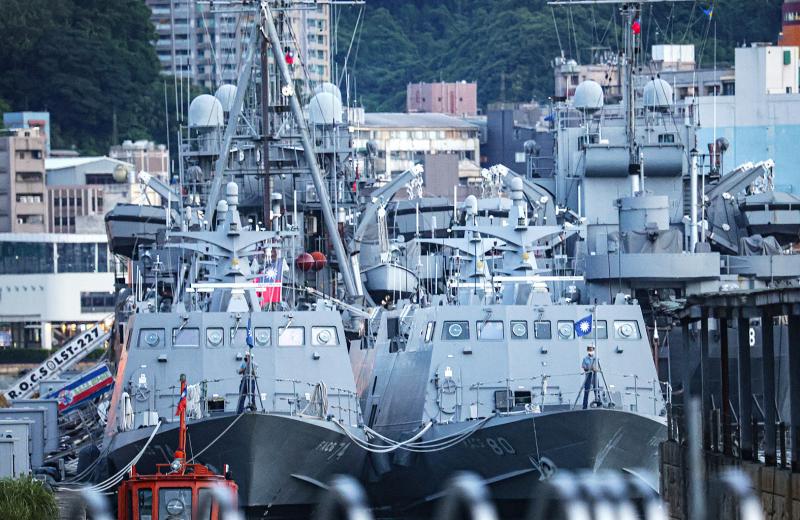The nation should build a class of second-line ships to offset the numerical advantage of Chinese frigates, Democratic Progressive Party Legislator Wang Ting-yu (王定宇) said, referring to disputes that stalled the navy’s next-generation guided missile frigate program.
China continues to probe Taiwan’s sovereign waters, an effort spearheaded by its Type 054 frigates and Type 056 corvettes, he said, adding that the navy faces steep challenges in countering Chinese incursions due to its aging fleet, with most ship types designed during the Cold War.
The Chi Yang-class frigates — formerly operated by the US as Knox-class frigates — are powered by steam turbines that are inferior in power output and safety to the gas turbines modern warships use, he said.

Photo: CNA
Deploying the navy’s biggest warships after Type 056 corvettes to counter the incursions is not a worthwhile effort, he said.
However, Taiwan’s two Tuo Chiang-class corvettes, which have less than 700 tonnes of displacement, are too small for the job, despite their firepower, he said.
If the navy is resolved to carry on with the second-generation frigate program, a next-generation “second-rate” ship class should be created to give the fleet more bulk and perform reconnaissance and patrol missions, he said.
The proposed secondary ship type would be a replacement for the Chi Yang class, which is long overdue, he said.
Last year, the navy said its next-generation guided missile frigate program — which has a budget of NT$24.5 billion (US$816.1 million) — might not be finished by 2026 due to technical challenges.
While the frigates were intended to have advanced reconnaissance and defense capabilities, the navy and the Chungshan Institute of Science and Technology could not agree on the ships’ displacement or internal layout, the navy said.
As the program might have to be redesigned, delays to the program are likely, the navy said.
A source said on condition of anonymity that navy top brass are considering the introduction of a secondary combat ship class with a displacement of about 2,000 tonnes as a temporary measure to increase the fleet’s combat power.

Beijing could eventually see a full amphibious invasion of Taiwan as the only "prudent" way to bring about unification, the US Department of Defense said in a newly released annual report to Congress. The Pentagon's "Annual Report to Congress: Military and Security Developments Involving the People's Republic of China 2025," was in many ways similar to last year’s report but reorganized the analysis of the options China has to take over Taiwan. Generally, according to the report, Chinese leaders view the People's Liberation Army's (PLA) capabilities for a Taiwan campaign as improving, but they remain uncertain about its readiness to successfully seize

Taiwan is getting a day off on Christmas for the first time in 25 years. The change comes after opposition parties passed a law earlier this year to add or restore five public holidays, including Constitution Day, which falls on today, Dec. 25. The day marks the 1947 adoption of the constitution of the Republic of China, as the government in Taipei is formally known. Back then the Chinese Nationalist Party (KMT) governed China from Nanjing. When the KMT, now an opposition party in Taiwan, passed the legislation on holidays, it said that they would help “commemorate the history of national development.” That

Trips for more than 100,000 international and domestic air travelers could be disrupted as China launches a military exercise around Taiwan today, Taiwan’s Civil Aviation Administration (CAA) said yesterday. The exercise could affect nearly 900 flights scheduled to enter the Taipei Flight Information Region (FIR) during the exercise window, it added. A notice issued by the Chinese Civil Aviation Administration showed there would be seven temporary zones around the Taiwan Strait which would be used for live-fire exercises, lasting from 8am to 6pm today. All aircraft are prohibited from entering during exercise, it says. Taipei FIR has 14 international air routes and

The Ministry of National Defense (MND) today released images of the military tracking China’s People's Liberation Army (PLA) movements during the latest round of Chinese drills around Taiwan. The PLA began "Justice Mission 2025" drills today, carrying out live-fire drills, simulated strikes on land and maritime targets, and exercises to blockade the nation's main ports. The exercises are to continue tomorrow, with the PLA announcing sea and air space restrictions for five zones around Taiwan for 10 hours starting from 8:30am. The ministry today released images showing a Chinese J-16 fighter jet tracked by a F-16V Block 20 jet and the